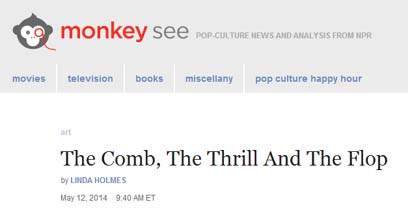THOUGHTS AS SHE READ 'DEVIL'S CANDY' AND EXPERIENCED OTHER ART WORKS OVER WEEKEND
 In a "Monkey See" essay for NPR, Linda Holmes discusses three pop culture activities she experienced last weekend, including reading Julie Salamon's The Devil's Candy, which details the making of Brian De Palma's The Bonfire Of The Vanities. One of the other two activities involved spending about five hours on Saturday at the Metropolitan Museum Of Art with a rented audio guide unit. The third is described by Holmes at the beginning of this excerpt from her essay:
In a "Monkey See" essay for NPR, Linda Holmes discusses three pop culture activities she experienced last weekend, including reading Julie Salamon's The Devil's Candy, which details the making of Brian De Palma's The Bonfire Of The Vanities. One of the other two activities involved spending about five hours on Saturday at the Metropolitan Museum Of Art with a rented audio guide unit. The third is described by Holmes at the beginning of this excerpt from her essay:Saturday night at 8:00, I saw a live performance of The Thrilling Adventure Hour, Ben Acker and Ben Blacker's "staged production in the style of old-time radio." It was packed with comedy podcast royalty and guests, including Paul F. Tompkins, Scott Aukerman, Scott Adsit, Paget Brewster, Wyatt Cenac, Busy Phillips, Zachary Levi, Jonathan Coulton, Paul and Storm, John Hodgman, Marc Evan Jackson, too many funny people to list if we're being perfectly serious as you can now see, and Dick "Yes, That Dick Cavett" Cavett. They performed radio plays about vampires, Martians, time travel, glamorous married people drinking to excess, robot hands, a succubus, and roving bands of invisible stupid wise men. The audience at Town Hall whooped and roared so unreservedly that a lady sitting near me kept sticking her fingers in her ears, overwhelmed.
In between, and all weekend, I read The Devil's Candy: The Anatomy Of A Hollywood Fiasco, Julie Salamon's 464-page, more than 20-year-old book – dishy, sad, and fascinating – about the making and flopping of Brian De Palma's film The Bonfire Of The Vanities. In the book, a project that begins with the conviction that adapting Tom Wolfe's novel can only result in the rare film both admirable and popular suffers wound upon wound: an unrealistic schedule, unrelenting industry gossip, a cynical casting change, location debacles (one involving a scene that couldn't be shot as planned in the Temple of Dendur), resistance in the Bronx to stereotypical depictions thereof, enormous egos coexisting about as successfully as a family of elephants in a college dorm room, and the fact that from the beginning, Wolfe's acidic outlook seems utterly incompatible with the desire – and, given the money being spent, the imperative – to make a hit.
At the museum, there is an ivory comb from the Egyptian Predynastic Period. Roughly 3200 B.C., they say. They suggest it might have been part of the accoutrements of someone's funeral more than 5000 years ago; more than 20 times the entire history of the country the museum is housed in. More than 115 times as long as I've been alive. The teeth of the comb are broken off; what remains is a little more than two inches tall and a little less than two inches wide, and those four square inches hold more than 20 individual renderings of animals. The carvings have symbolic significance, but they're also carefully and elegantly done, particularly on a piece so small. The comb played a role, perhaps, in an important ritual, but it's also a beautiful object, like many of the drums and bowls and pieces of blown glass.
The piece was, then, meant to be an offering of the artist's skills, to convey a meaning, to evoke an emotion, and to bring pleasure. So was The Bonfire Of The Vanities. So was The Thrilling Adventure Hour.
Those aren't the only purposes to which these other works are being put: the film was also engineered to make money, of course, perhaps cripplingly so. The live show, while far less damned by its relationship to commerce, is part of the performers' livelihoods particularly in the broad sense, since many of them remain people whose projects might well be described using, at some point, the word "cult." It supports you, the cult, but only sometimes does it keep you in food and shelter. And it demands to be fed in return, of course.
The Bonfire Of The Vanities didn't just aspire to keep people in food and shelter; it aspired to keep people in mansions and private planes. What it doesn't have that The Thrilling Adventure Hour has is an animating love of the material. Everyone involved seemed to have assumed Wolfe's book was capital-G Great, whether or not they had read it, but they began excising its controversial elements – which in this case meant its essential elements – almost immediately. There was so much money, there were so many trailers, there was so much fake rain, there were so many gowns and extras ... but the way Salamon tells the tale, few of them were – maybe nobody was – there for love.
Updated: Thursday, May 15, 2014 12:07 AM CDT
Post Comment | View Comments (1) | Permalink | Share This Post



